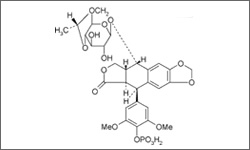Etoposide

Etoposide is used in the treatment of small cell and other lung cancers, gastric cancer, germ cell tumors and Lymphoma. Etoposide may be administered intravenously or in pill form.1
- 1Chu, E., & DeVita, V. T. (2015). Physicians' cancer chemotherapy drug manual 2015. Burlington, MA: Jones & Bartlett Learning.
Etoposide is a plant alkaloid, which looks to alter negative activity in the late S and G2 phases of the cell cycle. Specifically, Etoposide is instrumental in the inhibition of topoisomerase II, as it works to prevent the unwinding of harmful DNA.1
The diagram below shows the 3D molecular structure of Etoposide.
- 1Chu, E., & DeVita, V. T. (2015). Physicians' cancer chemotherapy drug manual 2015. Burlington, MA: Jones & Bartlett Learning.
Common side effects include alopecia (hair loss), decreased white blood cell count, nausea. Birth defects are possible; women who are pregnant or thinking of becoming pregnant should not take this drug. Patients may also experience an increased tendency to bleed and should avoid taking aspirin, as this 'thins' the blood increasing the chance of bleeding. Etopside may have a negative affects on the the immune system. Because of this, patients should not receive immunizations while being treated. 1
- 1Chu, E., & DeVita, V. T. (2015). Physicians' cancer chemotherapy drug manual 2015. Burlington, MA: Jones & Bartlett Learning.
